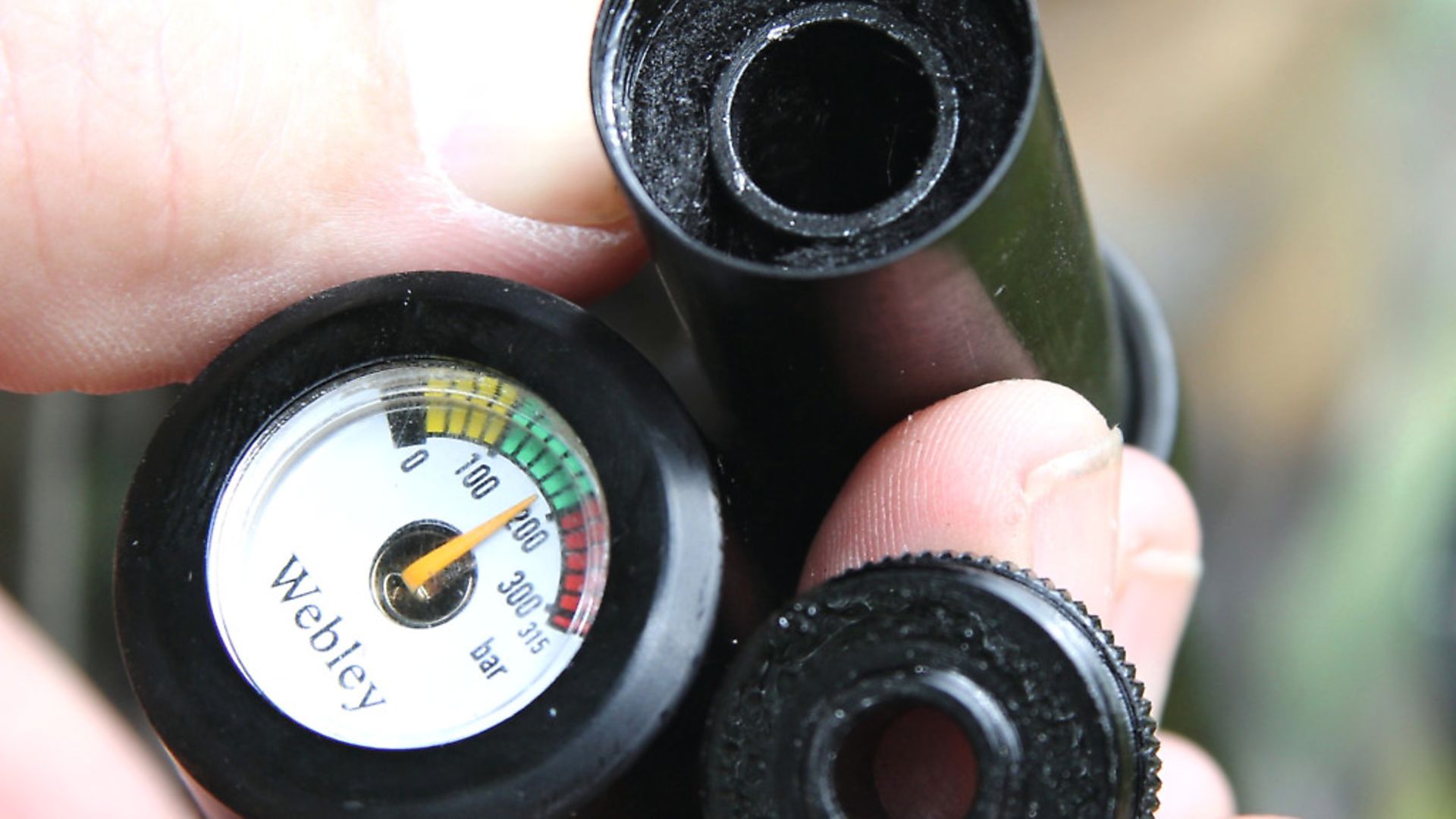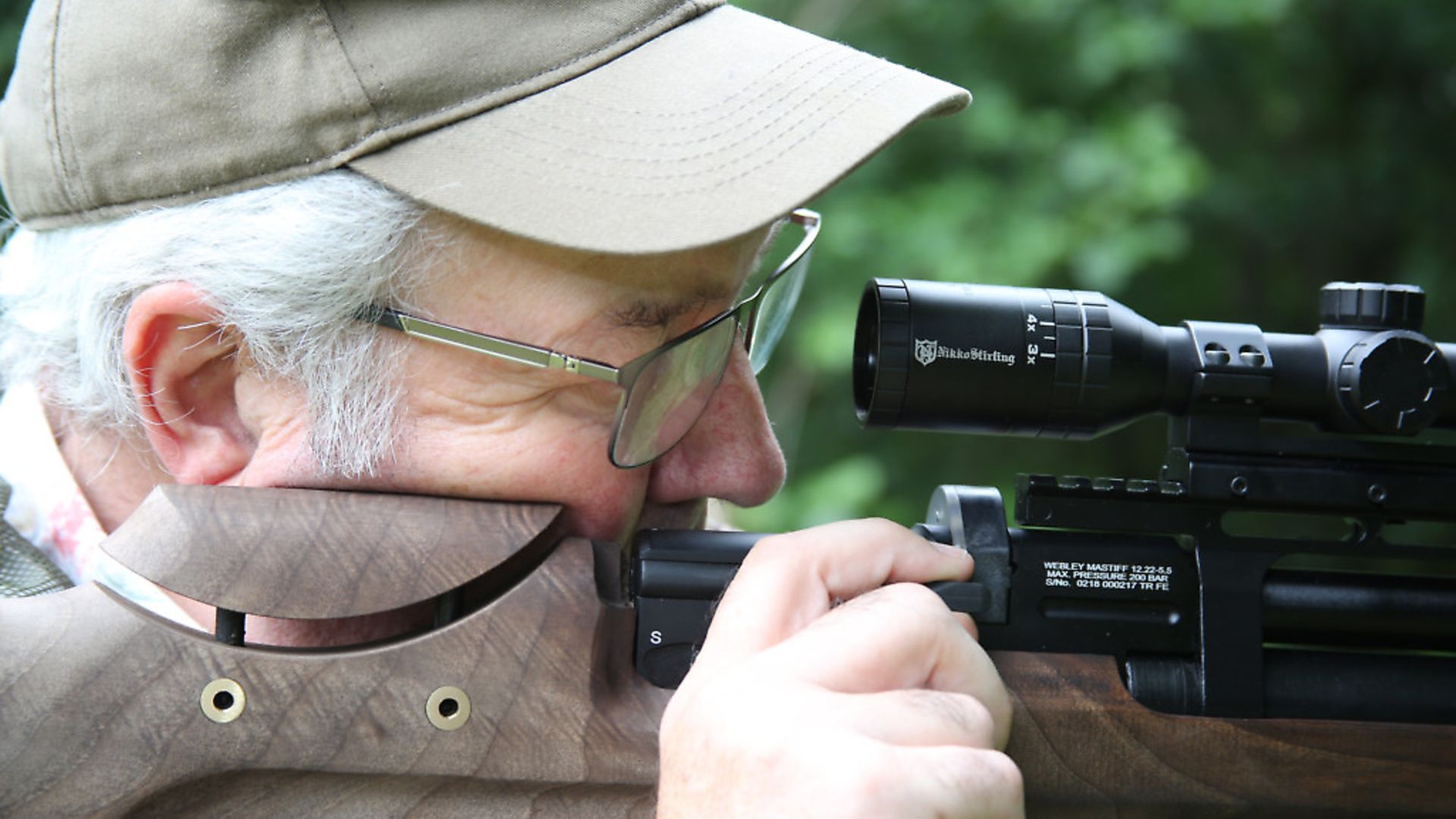Here’s the editor’s latest candidate for the missing link between bullpup and traditional rifle
 credit: Archant
credit: Archant
When is a bullpup not a bullpup? When it’s … erm … a bit longer and it’s called a ‘semi-bullpup’. I have just such a rifle in the gun rack next to me as I write, and I’ve been wanting to have a proper play with it ever since I handled the prototype quite a while ago. It’s the Webley Mastiff, and as you can see, being ‘a bit longer’ changes the game considerably, at least on the looks front. The change in handling is every bit as significant, but I’ll get to that later, after we’ve completed the traditional tour of this month’s test rifle.
The Webley Mastiff
What we have here is a pre-charged pneumatic ‘semi-bullpup’ rifle, running a sidelever action, that can be either multi- or single-shot, according to whether you fit the supplied rotary magazine or the, also supplied, single pellet tray. The .22 test rifle’s mag’ holds 12 pellets and its .177 counterpart takes 14.
Charging comes courtesy of a probe, with the 280cc air reservoir’s inlet port protected by a sliding cover, the front face of which holds a pressure gauge. I’d prefer all on-board pressure gauges to be sited away from the muzzles of our guns, but until that day comes, I’ll stick to ensuring that the rifle is neither cocked nor loaded, and always checking the air reserves with a sideways glance.
 credit: Archant
credit: Archant
Top stock
An ambidextrous thumbhole walnut stock is the handle of choice, and this offers the ideal combination of a vertically adjustable butt pad and cheek piece. In fact, the push-button mechanism on the butt pad is one of the neatest gadgets I’ve seen on an airgun, making adjustment between shots the work of a second. Shifting the cheek piece up and down involves the use of a supplied hex wrench, but the range of adjustment on offer was way more than I needed, so another plus there.
A stippled panel on the underside of the fore end does its bit for a secure hold, but it’s the overall design of this stock that supplies its commendable control, plus those crucial adjustable features, of course. The subtle palm swell acts alongside the thumbhole to support a relaxed trigger hand, with no need of a shelf at the base of the grip, and a set of sling swivels are fitted for those who prefer them. Personally, I’d remove the front swivels to give more leading hand position options, but those of a less simian build might prefer things as supplied.
Finally, the stock on the test rifle was crying out for a massage with walnut oil or something similar. I’m certain all new Mastiff owners will enjoy bringing out the grain in the Turkish timber, and I’ll be doing just that for the follow-up test.
 credit: Archant
credit: Archant
Trigger tweaks
Most bullpups, even the ‘semi’ versions, require a reconfigured trigger mechanism, usually built around an extended link between the trigger blade and the mechanism proper. The link on the Mastiff’s trigger is short, stiff and inflexible; more of a strut than a link, and the connection between finger movement and shot release is therefore direct.
Adjustment means removing the Mastiff’s stock – just a single bolt accessed from the base of the grip - and the synthetic trigger shoe, so have everything prepared and put that shoe and its fastenings in a safe place. Follow the supplied instructions, but either re-fit the shoe before settling on the finished adjustment, or set the trigger slightly more ‘safe’ than you prefer, because the shoe effectively ‘lightens’ the let-off by spreading the load across your finger pad. Take a ton of time to get that trigger just right, and you’ll be amply rewarded, I promise.
 credit: Archant
credit: Archant
Barrel and scope mount
In what seems to be a gathering trend, Webley has gone with a Picatinny rail for the Mastiff, although I’ve heard it referred to as a Weaver. The differences between these systems isn’t totally clear to me, beyond my working knowledge that Picatinny is becoming the norm, so I’ve asked our esteemed Technical Editor, Phill, to provide an explanatory feature on both. Webley say it’s a Picatinny, so that’s plenty good enough for me. The important thing is, any set of quality mounts that fit this rail, won’t be shifting.
A 16-inch (40cm) ‘precision rifled, match-grade barrel’ is another of Webley’s descriptions, and I can add ‘fully shrouded and ballistically baffled’ to that. Inside the shroud, the barrel is surrounded by baffles and sound-absorbent material, plus the shroud is braced at three points by ‘figure 8’ supports attached to the reservoir, so that rules out the ‘fully-floating’ label. My early accuracy tests show no deviation in pellet impact points as the air supply is used up, so the barrel system is doing what it’s designed for.
The Mastiff’s bark can be further muted by the optional purchase of a half-inch UNF replacement muzzle end cap, to which may be screwed a Hogan Decimeater or Webley’s QGS silencer. I’m quite happy to use the Mastiff with the degree of noise suppression supplied, but if whisper-quiet is your only accepted standard, you’re well catered for.
 credit: Archant
credit: Archant
Getting prepared
Each 190 to 200 bar charge of air – this rifle is unregulated, so carry out tests to find the optimum fill pressure – will yield at least 100 shots in .22 and around 80 in .177. As ever, keep the charging probe spotless and preferably protected whenever it’s not being used, and spin back that inlet valve cover immediately after charging – just basic, essential stuff.
Magazine matters
Loading the Mastiff’s removable rotary magazine is simple: just rotate the clear plastic cover in the direction of the arrow until it stops to reveal the first pellet chamber. Now, hold the spring tension, place a finger over the base of the chamber to stop the pellet falling through, and drop in the first round, nose first. You can release the tension now, and that first pellet will be held safely whilst you slide round the clear cover, loading pellets as you go until the mag’ is full. Contrary to what I’ve seen and read in certain places, the first pellet doesn’t have to go in skirt-first – it’s all perfectly straightforward.
Now, apply the manual safety, fully draw back the Mastiff’s sidelever and slide in the loaded magazine from the right-hand side. Close the lever, disengage the safety, and the rifle is ready to shoot.
Scope sorted
Thanks to the Mastiff’s adjustable stock, I had it fitting me and zeroed within half an hour, and I wasn’t hurrying, either. Sliding a scope back and forth on a Picatinny rail isn’t as easy as it is with dovetails, mainly because the ‘cross-bolt’ design stops anything sliding, even after the mount’s fixing bolts have been slackened off. This means the scope has to be lifted from the rail, moved back or forward, then secured, rather than ‘crept’ along to its ideal position. Again, please persevere and never, ever settle for second-best, because a properly aligned scope makes a massive difference to your results.
Function and accuracy
First, most users will appreciate the Mastiff’s side lever being in a convenient, visible, more forward, position, and cycling shots is slick and easy.
This operation isn’t as effortless as with certain other sidelevers, but they usually cost several hundred quid more than the Mastiff’s £530 price tag, so a little extra input won’t be resented.
Trigger function will be mainly defined by your adjustments, but the two-stage precision is there for the taking, and the neat shoe is a definite winner.
Pre-test chrono’ testing revealed a muzzle energy of exactly 11 ft.lbs. with Air Arms Diabolo Field straight from the tin, and a ‘best 50 shots’ average variation of 14 f.p.s., from a 190 bar charge. My last chrono’ check before going to press showed the muzzle energy holding steady at 11.2 ft.lbs., with consistency the same. Nothing wrong there, then.
I chose to shift focus from my 35-yard zero target, to a metal rat with a 20mm reset zone, set at 45 yards. I absolutely hammered that rat, until duty called and I switched back to paper for a definitive grouping session. My best groups at 40 yards averaged 18mm in diameter, so the Mastiff is capable of full-performance sporting use, of that I have no doubt. More pure accuracy testing will follow throughout the next month, but I know what I’m looking at, here, and it’s pleasingly impressive.
Initial verdict
The Webley Mastiff represents top value for money. It shoots straight, with reasonable consistency, especially for an unregulated rifle, and it handles extremely well. The stock adjustability is a major advantage, and apart from the loaded magazines rattling when I move, and the supplied hard case shedding its clasps and handles occasionally, there’s little to criticise and plenty to praise about this ‘not a bullpup’.
It’s already converted several of my shooting mates, and I’m sure it will do the same for you if you get behind one. I’m looking forward to more testing, but for now, this Mastiff really could be the ‘different format’ rifle you’ve been looking for.
Specification
Model: Mastiff
Manufacturer: Webley
Country of origin: UK/Turkey
Type: Pre-charged, multi-shot, semi-bullpup sporter
Calibre: .22, .177
Cocking: Sidelever
Loading: Via removable, rotary 12-shot magazine (14-shot for .177)
Trigger: 2-stage, adjustable
Stock type: Ambidextrous Turkish walnut
Weight: 3.95kg (8.7lbs)
Length: 840mm (33ins)
Barrel: 400mm (16ins)
Fill pressure: Max 200 bar (190 bar preferred on test rifle)
Variation over 50 shots: 14 fps for .22 on test
Average energy: 11.2 ft.lbs.
Contact: Webley on sales@highlandoutdoors.co.uk
Tel: 0845 099 0252
RRP: £529.99 includes 2 magazines, single-shot tray, probe charger, hex wrenches and hard case
__________________________________________________
See more gun tests from the editor...
BSA R-10 Super Carbine
Air Arms TDR S510
BSA Defiant